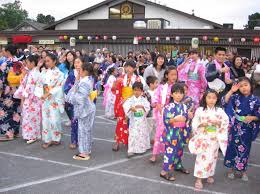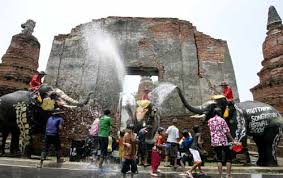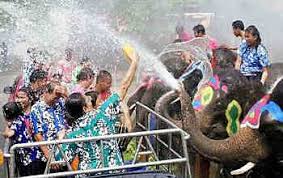OBON..
Obon is an annual Buddhist event for commemorating one's ancestors. It is believed that each year during obon, the ancestors' spirits return to this world in order to visit their relatives.Traditionally, lanterns are hung in front of houses to guide the ancestors' spirits, obon dances (bon odori) are performed, graves are visited and food offerings are made at house altars or temples.At the end of Obon, floating lanterns are put into rivers, lakes and seas in order to guide the spirits back into their world. The customs followed vary strongly from region to region. Obon is celebrated from the 13th to the 15th day of the 7th month of the year, which is July according to the solar calendear. However, since the 7th month of the year roughly coincides with August rather than July according to the formerly used lunar calendar. Obon is still celebrated in mid August in many regions of Japan, while it is celebrated in mid July in other regions. The Obon week in mid August is one of Japan's three major holiday seasons, accompanied by intensive domestic and international travel activities and increased accommodation rates.


The Inti Raymi ("Festival of the Sun") was a religious ceremony of the Inca Empire in honor of the god Inti, one of the most venerated gods in Inca religion. According to chronicler Garcilaso de la Vega, Sapa Inca Pachacuti created the Inti Raymi to celebrate the winter solstice and a new year in the Andes of the Southern Hemisphere. Since 1944, a theatrical representation of the Inti Raymi has been taking place at Sacsayhuaman on June 24 of each year, attracting thousands of tourists and local visitors. During the Inca Empire, the Inti Raymi was the most important of four ceremonies celebrated in Cusca, as related by Garcilaso de la Vega. The celebration took place in the Haukaypata or the main plaza in the city. The ceremony was also said to indicate the mythical origin of the Incas, lasting nine days of colorful dances and processions, as well as animal sacrifices to ensure a good cropping season. The last Inti Raymi with the Inca Emperor's presence was carried out in 1535, after which the Spanish conquest and the Catholic Church suppressed it. Some natives participated in similar ceremonies in the years after, but it was completely prohibited in 1572 by the Viceroy Francisco de Toledo, who claimed it was a pagan ceremony opposed to the Catholic faith. In 1944, a historical reconstruction of the Inti Raymi was directed by Faustino Espinoza Navarro and indigenous actors. The first reconstruction was largely based on the chronicles of Garcilaso de la Vega and only referred to the religious ceremony.
SONGKRAN..
Songkran is by far Thailand’s most fun holiday. The whole country shuts down for a few days, much like some people do over Christmas. But instead of retreating into their homes, Thai come out and celebrate with the community.Traditionally, the celebration involved sprinkling water over others to signify respect, cleanse away bad luck, and welcome in good luck and prosperity for the New Year. Nowadays the symbolic sprinkling has transformed into raucous water fights in the streets that last for three days, which comes in handy considering that Songkran is typically the hottest part of the year. Bangkok, Chiang Mai, Sukhothai, Ayyuthaya and Pattaya are all known for their wild Songkran celebrations, but nearly ever corner of the country celebrates Songkran.


FASCHING..
Fasching is carnival season. Originally it was a Pagan festival which came out of ancient Rome or Greece. In recent centuries, however, it has become more associated with the Christian Church. Officially the season starts on 11th November at 11:11am, although I've no idea why. It continues pretty low key for about 3 months. Things really begin to happen in February or March - 7 weeks before Easter. This is the week when people are allowed to "flip out" and behave recklessly before the beginning of Lent, which is a much more serious time.The Thursday before Ash Wednesday (25.Feb.2009) is known as "Weiberfastnacht", or "Women's carnival night". On this day tradition dictates that women are allowed to cut off the tie of any man within reach. So guys, don't wear your favourite tie to work that day! The women are also allowed to kiss any man they like. The following Monday is known as Rosenmontag (Rose Monday). On Rosenmontag there are various street processions involving lots of costumes and carnival floats. Faschingsdienstag (Carnival Tuesday) is the last day of Fasching and when most of the festivities happen. Faschingsdienstag is not an official holiday but workers usually get the afternoon off. Fasching around the world is celebrated mainly in the Catholic parts of Germany. Different areas give it different names, for example Karneval, Fastnacht, Fasnet, or Fosnat. Fasching is only the name used in and around Munich.


MARDI GRASS..
"Mardi Gras" means "Fat Tuesday." Traditionally, it is the last day for Catholics to indulge and often overindulge before Ash Wednesday starts the sober weeks of fasting that come with Lent. Formally known as Shrove Tuesday, Mardi Gras has long been a time of extravagant fun for European Christians. In fact, some people think Mardi Gras celebrations have their source in the wild springtime orgies of the ancient Romans.In the United States, Mardi Gras draws millions of fun-seekers to New Orleans every year. Mardi Gras has been celebrated in New Orleans on a grand scale, with masked balls and colorful parades, since French settlers arrived in the early 1700s. Hidden behind masks, people behaved so raucously that for decades in the early 19th century masks were deemed illegal in that party-loving city.
French royals, feather-covered showgirls, Energizer bunnies, painted clowns, masked lions you can find them all (and countless others) in the streets of New Orleans at Mardi Gras. By dawn on that most famous Tuesday, people have claimed the best spots on the streets to watch fabulous floats, outrageous performers, and visiting celebrities go by. Many travel hundreds of miles to be a part of the excitement. Marching bands, some of them founded more than a century ago, also take to the streets with music and festive dress. They open the day by spreading jazz music through the city before the more than 350 floats and 15,000 costumed paraders take over the scene. Crazy costumes and wild make-up are the order of the day for paraders and parade-watchers alike. The most lavish get-ups can be seen at the cross-dressing beauty pageants in the French Quarter, where bawdy costuming may reach new heights (over seven feet, in heels).

